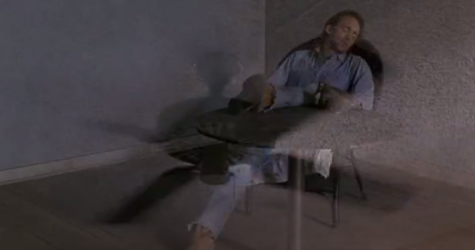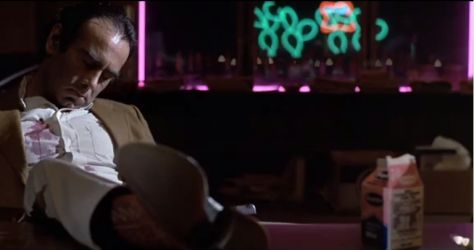“Something can always go wrong.”
Blood Simple (1984) is a classic Coen brothers film, as it should be, considering it was their directorial debut. It is a modern film noir, set in Texas, about the bloody dealings of a bar owner, his estranged wife, and a detective-turned-hitman. Because it is the Coen’s debut film, it features a lot of compositional elements they later use, among them the wide-shot frame and the way they edit their dialogue.
Composition: Wide Shots
The Coens favor wide shots heavily because it gives a full scope of the landscape, something that often influences their films (the desolate snowy fields of Fargo, the backroads and flat plains of Texas), and the setting in general. Wide shots are also often a good indicator of personality; they allow us to see aspects of sets and backdrops that we otherwise normally wouldn’t see in close-ups, when our focus is solely on the center of the shot.
When it comes to dialogue and conversation, the Coens like to start wide, then narrow in on the person talking; they establish the mood of the participants, then zero in on the meat of the conversation. Let’s compare two clips, one from Blood Simple and the other, the famous coin toss, from No Country For Old Men (2007):
In both, we start off with a wide shot; we see the front seat of the car in full, the Detective (M. Emmett Walsh) and Marty (Dan Hedaya) having a conversation about a hit on Marty’s wife, Abby (Frances McDormand). In No Country, we see a large, flat landscape, something the Coens like to employ in a number of their films, because it makes everything feel solitary – as they say in Blood Simple, “in Texas, you’re on your own” -before we focus on the inside of the gas station, both characters in full view as well.
With the next shot in both movies, we get closer; this signifies to us that an important conversation is going to take place, something we don’t want to miss. As the characters begin talking, we are treated to a quick shot, back and forth, as they each say their lines. What this does is keep us at pace with the conversation, as if we are there listening to it. When someone talks, your focus is fully on them, which is what the Coens want. Quick cuts keep us invested; if both were shot with one angle, it would become boring fast.
The Coens also use wide shots for other means of establishment, such as characterization. In Marty’s office, we often see on his desk a pint of milk; combined with his constant burping, this tells us he has indigestion, a weak constitution. This is why he hires the Detective, because he cannot bring his fantasies to fruition.
Also in Marty’s office, we see Ray (John Getz) piecing together what happened the night Marty was shot; we see the glass of milk, the dead fish, and the lighter on Marty’s desk, reminding us of the tangled story that runs underneath what we are seeing.

They could have just tracked Ray from his upper torso as he walked to the desk, but he is not the focus of the shot, the fish, the milk, and the lighter are. We are told through a slow focus of the lens that this is what we should be paying attention to.
The Coens, especially in this film, like to create shots that bleed into others. When Abby stays at Rays house, there is a succession of quick cuts to the three main players, embroiled in the dynamics of the love triangle: Abby, Ray, and Marty, who are all in similar states of posed reflection. A shot of the ceiling fan transfers to another, panning up from Marty and down to Abby. Ray and Marty are shot in similar positions, with their hands at the back of their heads. Later, after craning up and back down from a shot of a ceiling fan, Ray is sitting in the exact same position that Marty was shot in, complete with the transitory shot of the ceiling fan.


There is also a noted use of tracking and dolly shots. Their use is established early: we follow the dog as it walks through the house, we trail down the bar, catching a dead drunk as the bartender chats up a girl.
 Not only is it useful because it exposes us to the setting, but its initial featuring in relatively calm scenes lulls us into a false sense of security before it’s used in action sequences, or scenes that are otherwise heightened. We first see this when Marty attacks Abby in Ray’s house, then again when the Detective breaks in; an interesting note is that it is the exact same path, from the hallway to the front door, focusing on Abby’s purse.
Not only is it useful because it exposes us to the setting, but its initial featuring in relatively calm scenes lulls us into a false sense of security before it’s used in action sequences, or scenes that are otherwise heightened. We first see this when Marty attacks Abby in Ray’s house, then again when the Detective breaks in; an interesting note is that it is the exact same path, from the hallway to the front door, focusing on Abby’s purse.
Tracking shots allow us to be in the moment with the characters; we see and move along and discover things with them. This is especially useful in horror movies, and psychological thrillers, the latter of which Blood Simple falls under. It is a good means of injecting instantaneous investment into a film because it puts us on par with what’s happening.
This investigation into film noir gives us a lot of classic hallmarks that the Coen brothers use later, from wide shots to conversational cutting. Blood Simple is in the Criterion Collection for a reason – it is a strong debut from filmmakers who demonstrate early that they know what they are doing and how to do it, and it kicked off a fruitful and creative career that continues today.
